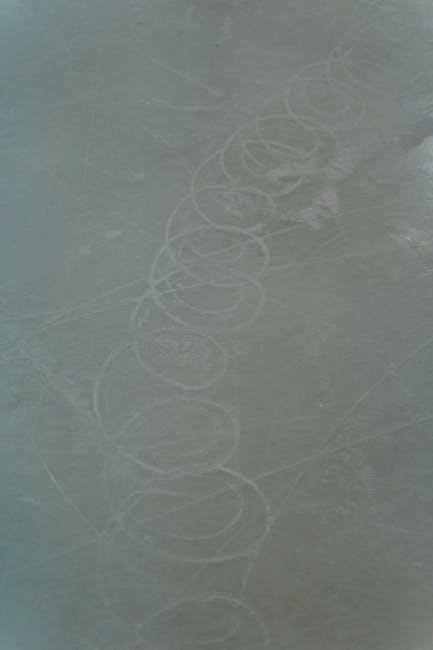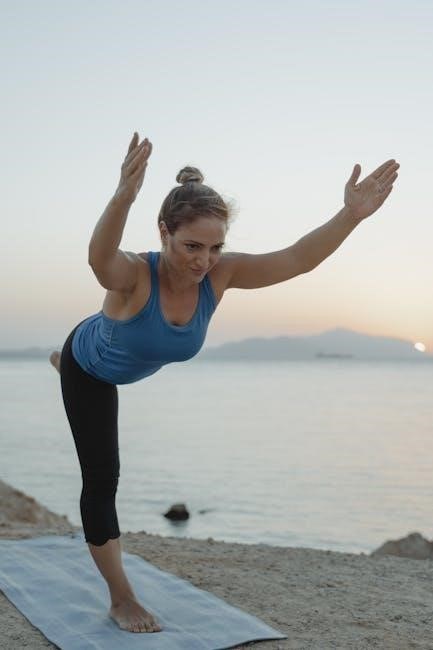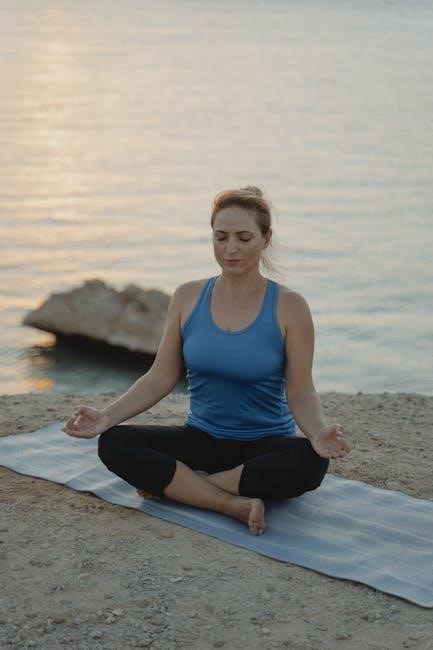Scapular dyskinesis refers to abnormal scapular movement patterns, often causing shoulder dysfunction. Targeted exercises aim to restore proper scapular mechanics, improving strength, control, and posture. These exercises are essential for addressing shoulder pain and enhancing overall shoulder function, ensuring proper movement patterns and reducing injury risk. Regular practice, combined with professional guidance, promotes long-term shoulder health and stability.
1.1 Definition of Scapular Dyskinesis
Scapular dyskinesis refers to the abnormal or altered movement patterns of the scapula during arm movements, leading to impaired shoulder function. It is characterized by a loss of normal scapulohumeral rhythm, where the scapula and humerus do not move in coordination. This dysfunction can result in pain, limited mobility, and poor posture. Scapular dyskinesis is often associated with muscle imbalances, such as weakness in the stabilizing muscles or overactivity in the dominant muscles. Proper diagnosis is essential to identify these abnormal patterns, as they can lead to conditions like shoulder impingement or rotator cuff injuries. Understanding the definition is crucial for developing effective treatment strategies, including targeted exercises to restore normal scapular mechanics and improve overall shoulder health.
1.2 Importance of Scapular Health

Scapular health is vital for maintaining proper shoulder mechanics, preventing injuries, and ensuring optimal upper body function. The scapula acts as the foundation for shoulder movement, and its stability is crucial for activities ranging from daily tasks to athletic performance. Poor scapular health can lead to conditions like shoulder impingement, rotator cuff injuries, and chronic pain. Maintaining strong, flexible, and well-coordinated scapular muscles ensures efficient energy transfer between the trunk and arm, enhancing performance and reducing fatigue. Additionally, good scapular health promotes proper posture, which can prevent long-term musculoskeletal issues. Addressing scapular dysfunction through targeted exercises is essential for restoring balance and improving overall shoulder function, making it a cornerstone of rehabilitation and injury prevention programs;

1.3 Benefits of Scapular Dyskinesis Exercises
Engaging in scapular dyskinesis exercises offers numerous benefits, including improved shoulder stability, enhanced strength, and better overall posture. These exercises target the muscles surrounding the scapula, such as the trapezius, rhomboids, and serratus anterior, which are essential for proper shoulder mechanics. By strengthening these muscles, individuals can reduce the risk of shoulder injuries and alleviate chronic pain. Additionally, scapular exercises promote scapulohumeral rhythm, the synchronized movement of the scapula and humerus, which is crucial for efficient arm movements. Improved neuromuscular control and flexibility are also achieved, allowing for better performance in daily activities and sports. Furthermore, these exercises can enhance core stability, as the scapula plays a role in transferring forces between the upper body and the rest of the kinetic chain. Regular practice of scapular exercises fosters long-term shoulder health and functionality, making them a key component of both rehabilitation and preventive care.

Causes and Risk Factors of Scapular Dyskinesis
Scapular dyskinesis often results from muscle imbalances, poor posture, or traumatic injuries, disrupting normal scapular movement and leading to shoulder dysfunction and repetitive strain, affecting daily activities and sports performance.
2.1 Muscle Imbalances in the Shoulder Region
Muscle imbalances in the shoulder region are a primary contributor to scapular dyskinesis. Overactivity or underactivity of key muscles, such as the trapezius, rhomboids, and serratus anterior, disrupts scapular mechanics. When these muscles fail to function in harmony, it leads to altered movement patterns, potentially causing pain and dysfunction. For instance, weakness in the serratus anterior can result in scapular winging, while overactivity in the upper trapezius may cause excessive scapular elevation. These imbalances often stem from poor posture, repetitive movements, or insufficient strength training. Addressing muscle imbalances through targeted exercises is crucial for restoring proper scapular function and preventing further injury. Strengthening weak muscles and stretching tight ones helps rebalance the shoulder region, promoting optimal scapular movement and overall shoulder health. Early identification and correction of these imbalances are essential for effective rehabilitation and long-term prevention of scapular dyskinesis.
2.2 Poor Posture and Its Impact on Scapular Movement
Poor posture significantly contributes to scapular dyskinesis by altering normal movement patterns of the shoulder blade. Forward head posture and rounded shoulders are common postural deviations that disrupt scapular mechanics. These positions can lead to abnormal muscle activation, causing the scapula to wing, tilt, or rotate improperly during arm movements. Over time, prolonged poor posture creates muscle imbalances, with weakened scapular stabilizers and tightness in the chest and shoulder muscles. This imbalance disrupts the scapulohumeral rhythm, essential for smooth shoulder function. Addressing postural issues is critical for restoring proper scapular movement and preventing further dysfunction. Exercises targeting postural correction, such as chin tucks and shoulder blade squeezes, can help improve alignment and reduce the risk of scapular dyskinesis. Correcting posture early on is vital for maintaining healthy shoulder mechanics and overall upper body mobility.
2.3 Trauma or Injury Leading to Scapular Dyskinesis
Trauma or injury to the shoulder or scapular region can directly lead to scapular dyskinesis by disrupting normal movement patterns. Direct blows, falls onto the shoulder, or fractures can cause immediate mechanical dysfunction. Indirect injuries, such as repetitive strain from sports or sudden arm movements, can also impair scapular mechanics. Trauma often results in muscle imbalances, inflammation, or structural damage, which disrupts the coordination of scapular stabilizers. For example, injuries to the rotator cuff or labrum can force the scapula to compensate, leading to abnormal movement. Post-traumatic scapular dyskinesis may cause pain, limited mobility, and reduced functional ability. Prompt rehabilitation is essential to restore proper scapular function and prevent chronic dysfunction. Targeted exercises, such as scapular retractions and wall slides, are often prescribed to address trauma-induced dyskinesis, promoting recovery and reducing the risk of future injury.

Diagnosis and Assessment of Scapular Dyskinesis
Diagnosis involves clinical tests like the scapular assistance test and observation of abnormal movement patterns. Assessments focus on identifying muscle imbalances, limited mobility, and altered scapulohumeral rhythm to confirm dyskinesis.
3.1 Clinical Tests for Scapular Dyskinesis
Clinical tests for diagnosing scapular dyskinesis include the scapular assistance test, which assesses scapular movement during arm elevation. Observing scapular winging, abnormal rotation, or limited mobility helps identify dyskinesis. Palpation of the scapula during movement can detect irregular muscle activation patterns. The clinician may also evaluate scapulohumeral rhythm to ensure synchronized movement between the scapula and humerus. Additionally, strength and flexibility assessments of the shoulder muscles, such as the rotator cuff and periscapular muscles, are performed. These tests collectively help determine the presence and severity of scapular dyskinesis, guiding the development of targeted rehabilitation programs. Early detection through these assessments ensures timely intervention, reducing the risk of further shoulder dysfunction or injury.
3.2 Observing Scapular Movement Patterns
Observing scapular movement patterns is crucial for diagnosing dyskinesis. Clinicians visually assess how the scapula moves during arm elevation, noting any asymmetry, winging, or abnormal rotation. Patients with dyskinesis often exhibit poor posture, such as rounded shoulders or a protracted scapula. Manual techniques, like palpation, help identify irregular muscle activation patterns. The scapula’s ability to upwardly rotate, posteriorly tilt, and retract during arm movement is evaluated. Any deviation from normal movement, such as excessive protraction or limited upward rotation, indicates potential dyskinesis. These observations, combined with clinical tests, provide a comprehensive understanding of scapular function. Accurate assessment ensures targeted exercises are prescribed to address specific movement impairments, promoting proper scapular mechanics and overall shoulder health. Regular observation also helps track progress during rehabilitation, ensuring effective treatment outcomes.

Role of Exercises in Treating Scapular Dyskinesis
Exercises play a vital role in treating scapular dyskinesis by restoring normal movement patterns, improving muscle balance, and enhancing posture; They address muscle imbalances, strengthen stabilizers, and promote proper scapular mechanics, reducing pain and improving shoulder function. Regular practice helps prevent recurrence and supports long-term shoulder health.
4.1 Strengthening the Scapular Stabilizers
Strengthening the scapular stabilizers is crucial for addressing scapular dyskinesis. These muscles, including the trapezius, rhomboids, and levator scapulae, play a key role in maintaining proper scapular mechanics; Weakness or imbalances in these muscles can lead to abnormal movement patterns, contributing to shoulder pain and dysfunction. Exercises such as scapular retractions, shoulder blade squeezes, and wall push-ups are highly effective for strengthening these stabilizers. Progressing to resistance-based exercises, like Theraband rows, further enhances muscle strength and control. It is important to perform these exercises with proper form to avoid compensatory movements. Strengthening the scapular stabilizers not only improves shoulder stability but also enhances overall posture and reduces the risk of injury. Consistency in performing these exercises, combined with professional guidance, is essential for achieving optimal results and restoring normal scapular function.
4.2 Improving Scapulohumeral Rhythm
Improving scapulohumeral rhythm is vital for restoring normal shoulder mechanics and addressing scapular dyskinesis. Scapulohumeral rhythm refers to the synchronized movement between the scapula and humerus during arm elevation. Dyskinesis often disrupts this rhythm, leading to inefficient and painful shoulder movements. Exercises that promote this rhythm include dynamic hugs, arm circles, and wall slides. These movements encourage the scapula to move in harmony with the arm, enhancing coordination and reducing strain on the shoulder joint. Progression to more dynamic exercises, such as overhead presses with resistance bands, further challenges and improves this rhythm. Proper form and controlled movements are essential to avoid exacerbating existing imbalances. By improving scapulohumeral rhythm, individuals can achieve smoother, more efficient shoulder function, reducing the risk of injury and enhancing overall upper limb performance. Consistent practice and professional guidance are key to optimizing these exercises and restoring normal shoulder mechanics.
4.3 Enhancing Neuromuscular Control
Enhancing neuromuscular control is a critical component of treating scapular dyskinesis, focusing on improving the coordination and timing of scapular muscles. Exercises such as wall push-ups, cross arm stretches, and resistance band rows help retrain the brain-muscle connection, ensuring proper activation patterns. These exercises emphasize controlled movements, promoting awareness of scapular positioning and reducing abnormal compensation patterns. By strengthening the connection between the nervous system and muscles, individuals can achieve more efficient and synchronized scapular movement. This reduction in muscle imbalances and improved proprioception leads to better overall shoulder function and reduces the risk of recurring dyskinesis. Progression to dynamic exercises, such as arm elevations with resistance, further challenges neuromuscular control, ensuring long-term improvements in scapular stability and movement patterns. Consistent practice and feedback are essential for optimizing these exercises and restoring normal neuromuscular control.
Exercise Program for Scapular Dyskinesis
A structured exercise program for scapular dyskinesis typically includes three phases: basic stabilization, intermediate strengthening, and advanced dynamic movements. Each phase progressively challenges scapular stability and promotes recovery.
5.1 Phase 1: Basic Scapular Stabilization Exercises
Phase 1 focuses on restoring foundational scapular stability through low-intensity exercises. These exercises target the activation of key stabilizers, such as the trapezius, rhomboids, and serratus anterior muscles. Techniques like shoulder blade squeezes, wall push-ups, and prone scapular retractions are commonly used. These movements help improve scapular control and posture without overloading the shoulder joint. Patients are encouraged to perform these exercises with controlled movements, emphasizing proper form to avoid compensation patterns. The goal is to reactivate dormant muscles and establish a baseline for more advanced exercises in later phases. Frequency and duration are tailored to individual tolerance, with progression based on symptom response and strength improvements.
5.2 Phase 2: Progressing to Intermediate Exercises
Phase 2 introduces intermediate exercises to build on the foundational stability achieved in Phase 1. These exercises incorporate controlled movements that challenge the scapular stabilizers with increased resistance or dynamic patterns. Examples include modified rows using Therabands, elevated push-ups, and dynamic arm movements with scapular control. The focus is on integrating scapular motion with arm movements while maintaining proper posture and avoiding compensatory patterns. Resistance levels are gradually increased, and exercises are performed in multiple planes to enhance functional strength. Patients are encouraged to focus on maintaining scapular control throughout each movement, ensuring that the shoulder blades move symmetrically. The duration and intensity of these exercises are adjusted based on individual progress and symptom tolerance, with the aim of preparing the shoulder for more complex activities in Phase 3.
5.3 Phase 3: Advanced Exercises for Full Recovery
Phase 3 focuses on advanced exercises to achieve full recovery and restore normal scapular mechanics. These exercises emphasize high-level strength, endurance, and dynamic control, preparing the shoulder for unrestricted activity. Examples include plyometric drills, such as medicine ball throws, and advanced resistance training using heavier weights or resistance bands. Dynamic movements, like overhead presses and multi-planar arm patterns, are incorporated to challenge scapular stability in functional positions. Additionally, exercises that mimic sports-specific or job-related activities are introduced to enhance practical application. The focus is on maintaining proper form while increasing intensity and speed. Patients are encouraged to progress gradually, ensuring no pain or compensatory movements. This phase aims to maximize scapular strength, endurance, and neuromuscular control, ensuring a seamless transition to daily activities or athletic performance without limitations.

Specific Exercises for Scapular Dyskinesis
Key exercises include scapular retractions, wall push-ups, and Theraband rows to strengthen stabilizers. Cross arm stretches improve flexibility, while plyometrics and dynamic movements enhance neuromuscular control and functional recovery.

6.1 Scapular Retraction Exercises
Scapular retraction exercises focus on strengthening the muscles that pull the shoulder blades together, improving stability and posture. A common exercise is the shoulder blade squeeze: sit or stand tall, squeeze the scapulae together without shrugging, and hold for 5-10 seconds. Repeat for 10-15 repetitions, 3 sets daily. For progression, perform prone scapular retractions: lie on your stomach with arms extended, squeeze the shoulder blades together, and lift arms slightly off the ground. Hold for 5 seconds, then lower. Start with 3 sets of 10 reps and gradually increase. These exercises enhance scapular control, reduce winging, and improve overall shoulder mechanics. Consistency and proper form are key to achieving benefits and preventing further dysfunction.
6.2 Wall Push-Ups for Scapular Control
Wall push-ups are an effective exercise for improving scapular control and strength without placing excessive strain on the shoulder joint. To perform, stand facing a wall, place hands shoulder-width apart on the wall at shoulder height, and engage the core. Slowly lower the body toward the wall, keeping elbows close to the body, while maintaining scapular stability. Avoid letting the shoulder blades wing or shrug during the movement. Push back to the starting position, squeezing the shoulder blades together at the top. Perform 3 sets of 10-15 repetitions daily. This exercise enhances scapular retraction, promotes proper movement patterns, and strengthens the muscles around the shoulder girdle. It is particularly beneficial for individuals with scapular dyskinesis, as it helps restore normal scapulohumeral rhythm and reduces the risk of shoulder injuries. Consistency and proper form are essential for maximizing benefits and preventing further dysfunction.
6.3 Theraband Rows for Strengthening
Theraband rows are a versatile and effective exercise for strengthening the muscles around the scapula, particularly targeting the rhomboids, trapezius, and latissimus dorsi. To perform, secure the Theraband to a stable object at shoulder height. Hold the ends of the band with elbows bent at 90 degrees, arms at your sides. Engage the core and pull the band toward your body, squeezing the shoulder blades together while maintaining proper posture. Avoid rounding the shoulders or using excessive force. Return to the starting position slowly and repeat for 3 sets of 12-15 repetitions. This exercise improves scapular stability, enhances neuromuscular control, and strengthens the muscles necessary for proper shoulder mechanics. It is particularly beneficial for individuals with scapular dyskinesis, as it helps restore balanced muscle activation and promotes functional movement patterns. Consistency and proper form are crucial for achieving optimal results and preventing further shoulder dysfunction.
6.4 Cross Arm Stretch for Flexibility
The cross arm stretch is a simple yet effective exercise for improving flexibility in the shoulder region, particularly targeting the pectoralis minor and major muscles. To perform, stand or sit with good posture. Bring one arm across your chest, placing the hand on the opposite shoulder. Gently press the arm with the other hand to deepen the stretch, ensuring not to cause discomfort. Hold for 20-30 seconds and repeat on the other side. This stretch helps reduce tightness in the anterior shoulder muscles, which often contributes to scapular dyskinesis. Regular practice can enhance shoulder mobility, reduce muscle imbalances, and improve overall scapular movement patterns. It is essential to perform the stretch gently to avoid injury and maintain controlled breathing to maximize relaxation of the target muscles. Incorporating this stretch into a daily routine can significantly contribute to restoring proper scapular function and reducing the risk of shoulder-related pain or dysfunction.

Progression and Variation of Exercises
Progression involves adding resistance and dynamic movements to challenge scapular stabilizers. Variations include modifying ranges of motion and incorporating functional activities to enhance strength and movement patterns effectively.
7.1 Adding Resistance to Scapular Exercises
Adding resistance to scapular exercises enhances strength and endurance of the stabilizing muscles. Techniques include using Theraband, resistance bands, or light weights. For example, Theraband rows involve anchoring the band and pulling to target the periscapular muscles. External rotations with resistance focus on improving rotational control. Progression can be achieved by increasing resistance levels or adding dynamic movements. Proper form is crucial to avoid compensatory patterns. Starting with low resistance and gradually increasing intensity ensures safe and effective strengthening. Incorporating resistance helps restore normal scapular mechanics and improves overall shoulder function. Always consult a physiotherapist to tailor resistance exercises to individual needs and prevent overloading.
7.2 Incorporating Dynamic Movements
Incorporating dynamic movements into scapular exercises enhances functional strength and coordination. Examples include arm circles, scapular rotations, and wall slides, which mimic real-world movements. These exercises improve muscle activation patterns and promote better movement efficiency. Dynamic exercises should be performed with controlled movements to avoid compensatory patterns. Progression can involve increasing speed or complexity, such as adding plyometric elements. Proper form and technique are essential to maximize benefits and prevent injury. Dynamic movements prepare the scapula for everyday activities and sports, ensuring optimal performance and durability. They are particularly effective in advanced stages of rehabilitation, helping to restore normal scapular mechanics in dynamic situations. Always prioritize quality of movement over quantity to achieve the best outcomes.

Home vs. Clinical Exercises
Home exercises offer convenience and consistency, while clinical exercises provide professional supervision and advanced equipment. Both settings aim to improve scapular function, with clinical exercises often addressing complex cases requiring specialized care.
8.1 Home Exercises for Scapular Dyskinesis
Home exercises are a convenient and effective way to address scapular dyskinesis, allowing individuals to maintain consistency without clinical supervision. Simple exercises like shoulder blade squeezes, wall push-ups, and cross-arm stretches can be performed daily. These exercises focus on improving scapular stability, strength, and flexibility. Patients are encouraged to start with low-intensity movements and gradually progress as comfort and strength improve. Proper posture and technique are crucial to avoid exacerbating the condition. It is recommended to consult a physiotherapist to tailor a home exercise program to individual needs, ensuring exercises are pain-free and effective. Regular practice at home can significantly enhance scapular function and overall shoulder health, making it a vital component of recovery and prevention strategies.
8.2 Clinical Exercises and Supervised Therapy
Clinical exercises and supervised therapy provide a structured approach to treating scapular dyskinesis, offering personalized guidance and advanced techniques. Under the supervision of a physiotherapist, patients engage in targeted exercises such as theraband rows, scapular retractions, and dynamic movements to restore proper scapular mechanics. These sessions often include manual therapy, such as joint mobilizations and soft tissue work, to address muscle imbalances and improve flexibility. Supervised therapy ensures that exercises are performed correctly, minimizing the risk of further injury and maximizing progress. Additionally, therapists can incorporate specialized equipment like physioballs and resistance bands to enhance strength and neuromuscular control. The clinical setting allows for continuous monitoring and adjustment of the exercise program, tailored to the patient’s specific needs and recovery stage, ensuring effective and efficient rehabilitation.